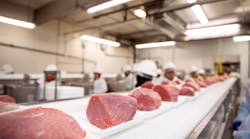The pandemic and its associated problems have affected production of every kind of food, but arguably no sector has seen greater impact than the meat & poultry industry.
COVID-19 outbreaks shut down production at mega-plants around the country in the early stages of the pandemic, causing interruptions in meat supplies. Beef prices went up 30% since the start of the pandemic, hitting a high of $7.90 a pound last October before beginning to decline. Production has resumed to full levels, but the supply-chain problems that have afflicted much of the world in general have hit the meat industry hard.
The situation has drawn the attention of the government, with the White House holding a summit in January with ranchers and retailers – but not processors. President Biden blames concentration in the meat industry for high consumer prices paired with low prices for ranchers, and he promises to encourage smaller producers and look at antitrust action against the big players. They and their trade associations have pushed back, arguing that the rise in meat prices has its roots in the same economic conditions that have affected the entire country, especially supply chain and labor issues.
The situation may well end up nudging meat & poultry into a few new directions, industry observers say. Labor is by far the biggest issue. The difficulties involved in attracting and retaining labor, always acute in meat processing plants, became exponentially harder during the pandemic; these challenges are likely to remain in place indefinitely. Solutions around labor will always be welcome.
Paradoxically, plants might have to increase their workforces to respond to the labor concerns of their trade customers. Case-ready meats – cuts packaged in the plant – have become more popular, says Brian Nicholas, a marketing specialist for Ross Industries: “We saw tremendous growth in our case-ready applications.”
Nichols is aware of the Biden administration’s initiative for smaller meat processors and thinks it’s a great idea, not least because it will free up money, in the form of loans and grants, for them to invest in startup or additional equipment.
Modular equipment such as this meat slicer can serve as a way to institute automation gradually. Photo: Ross Industries
“One of the fantastic things about the Biden administration's plan is the financing opportunities for small independent processors,” he says. “As more funds become available, we hope it presents smaller processors the opportunity to expand their capabilities or unlocks a path for new blood in the industry. Many of our current customers are small independent processors, and we look forward to the chance to helping others grow under some of these programs.”
The needs of smaller customers are pretty much similar to those of the bigger players, Nichols says. “Scale is the only thing that separates smaller processors from larger ones. The methods aren’t different, the volume is.” It’s therefore important for meat processing equipment to have the capacity to be scaled up as needed, he says.
Middleby Food Processing takes a similar approach, says Jean Luc Dréano, vice president of integration: “Smaller customers are looking for greater product flexibility with easy changeovers with different production series and a smaller footprint.
“However, they also want similar equipment features in automation/productivity and process controls which underscores the importance of automation and controls," he continues. "Middleby also scaled down systems to meet smaller production volumes as well as single machine solutions.”
Looking toward automation
Automation is an established goal for the meat & poultry industry – at least for some of the more forward-looking players. Tyson Foods, JBS and others have announced long-term initiatives to develop automated processing, especially for some of the more onerous tasks like carcass disassembly or chicken deboning.
When it comes to automating, there is a certain amount of inertia to overcome, industry observers acknowledge. Like much of the rest of the food industry, meat & poultry processors operate on thin margins and have an incentive to keep their existing equipment running as long as possible.
Increased automation is seen as a way to deal with both social distancing and challenges in maintaining staffing levels. Photo: Frontmatec
“I can tell you this. I come from the beef industry and I started in 1978 and I can tell you that some of the equipment that I ran in 1980, 1981, is still in the same place today that it was in 1981,” says Terry Davis, a project engineer with Midwest Machine.
However, the industry has also had some long-standing incentives to automate. Principal among these has been the difficulty in finding labor – a chronic problem that the pandemic has made worse across the board.
“The availability of labor to do these kinds of tasks, or the lack of availability, is similar whether you’re a Tyson or a Cargill or a smaller packer,” Davis says.
The pandemic has also made clear the importance of maintaining distance between workers whenever possible. Shoulder-to-shoulder working conditions contributed to the pandemic’s spread in meat & poultry plants; some of them responded by installing plastic barriers perpendicular to the line to make individual workstations.
“Certainly the interest for automation that allows for safe distance between workers in end-to-end automated processing lines is widely shared by our customers,” Dréano says.
Any solution to the distancing problem will probably have to touch on material handling in one form or another, making it faster and/or more responsive to conditions. For instance, beltless conveyors that use magnetism or air pressure to “float” load-bearing tiles across surfaces have the potential to customize line operations, allowing for more space between workstations.
Automatic guided vehicles, offered by Middleby among others, bring an added degree of flexibility to end-of-line operations, because they allow palletizing and load wrapping to be located at virtually any point in the plant.
Making the switch
As supplies of certain things become scarce, some processors are making substitutions. An example is frozen carbon dioxide, often used to quick-freeze cuts or pieces, or to chill ground meat prior to forming into shapes like patties or nuggets. Industrial carbon dioxide supplies have been falling, primarily due to the drop in demand for motor fuel caused by the pandemic. Carbon dioxide is a byproduct of production of ethanol, the plant-based alcohol widely used in the U.S. as a gasoline additive.
Messer LLC is offering systems that use liquid nitrogen as an alternative to CO2. It debuted a wave impingement freezer at the recent International Production & Processing Expo (IPPE) that operates with liquid nitrogen.
Meat and poultry processing lines of the future may have to be configured to allow greater distance between workers. Photo: Frontmatec
“The CO2 supply has been adversely affected by the reduction in ethanol demand in the U.S., and that has impacted available CO2 from those types of sources,” says Dan Morgan, Messer's director for food and beverage markets. “As a result, availability of CO2 to the food processing community has been reduced. So what we have done at Messer is actually develop some alternatives that provide liquid nitrogen for either chilling or freezing that provide a more reliable supply base of cryogen to meet their chilling and freezing needs.”
Morgan says that a recent customer, a major poultry processor, found that switching to nitrogen enabled them to double production on an IQF line while using fewer floor workers.
Suppliers’ supplies
Suppliers to the industry are facing their own supply-chain challenges, in getting the materials they need and getting their goods out the door.
“It is a daily issue, a daily obstacle, just trying to get enough raw materials in so we can produce and manufacture our products,” says Jennifer Lindsey, vice president of global marketing for Corbion, a supplier of preservatives and other components. “And then you have the added burden of just trying to get a truck to deliver the raw materials to you or to find a truck to get your finished product out to your customer. It is a daily issue that we’re just cycling through.”
In some cases, suppliers are dealing with a desire by some of their customers to stockpile supplies. This is especially prevalent for certain kinds of parts, like conveyor belts, that inevitably will wear out – and that are vital to replace immediately.
“I think a lot of what’s on their minds is supply chain issues, and they’ve really been making sure they have enough [belts] on hand to last them through any issues that may come up,” says Guy Mitchell, marketing media specialist of Wire Belt, a supplier of belts often used for cooked or further-processed products. “I think people have been ordering extra to have on hand, just because they are nervous about supply chain issues going forward.”
Availability of labor, supplies and transportation have all been roiled by the pandemic, especially in the meat & poultry sector. Success will come to the players that are nimble with substitutions, workarounds, and especially, long-term solutions, to the pandemic and to the industry’s other challenges.

